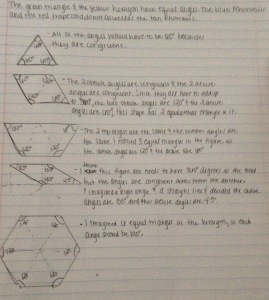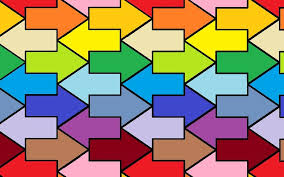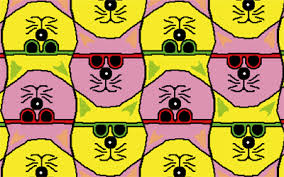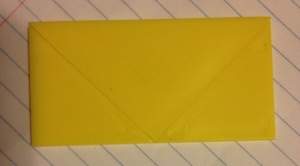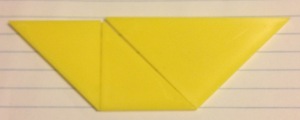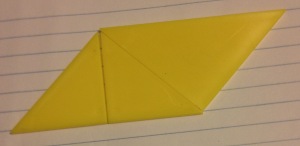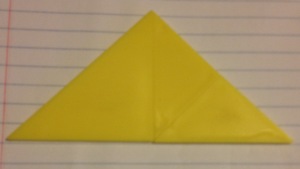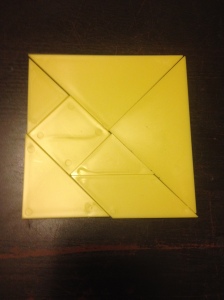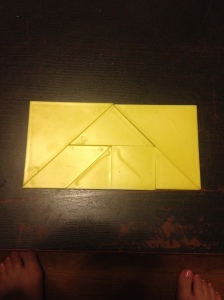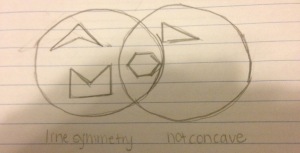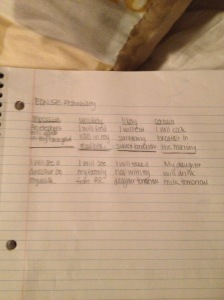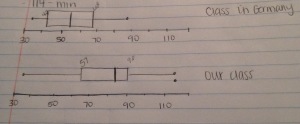Exploring Angles with Pattern Blocks
I got all of the angles right except for the tan rhombus. I found that two of the angles were 45 degrees and two of the angles were 135 degrees. The correct answer is two angles at 60 degrees and two angles at 150 degrees. Do you know how to find these measurements? How did you do on this activity?
Annenberg Video Circumference and Diameter
·Describe Ms. Scrivner’s techniques for letting students explore the relationship between circumference and diameter. What other techniques could you use?
-The teacher had students get measurements of different circular objects in the room then asked them what they noticed about the relationship between the two numbers. She also allowed the students to find the objects in the classroom for themselves. Another technique one could use is giving the students a basket or bag of objects to measure. This would minimize the moving around the room and limit misconceptions about what are circles and what are not.
·In essence, students in this lesson were learning about the ratio of the circumference to the diameter. Compare how students in this class are learning with how you learned when you were in school.
-In this class the students looked at the measurements they found and discussed the measurements in correlation with one another. The students were able to see that there was a ratio between the circumference and diameter of the circle. In school, I was given a piece of paper with the circumference and the diameters and discovered the relationship indivually.
·How did Ms. Scrivner have students develop ownership in the mathematical task in this lesson?
-Ms. Scrivner allowed the students to develop ownership in the mathematical task by allowing them to choose the objects they measured, instructed them to measure the object and record the data, share the data with the class, and lead a discussion discovering the relationship between the numbers. They lead this activity.
·How can student’s understanding be assessed with this task?
-The student’s understanding can be assessed by what they contribute to the discussion.
Annenberg Circles and Pi Module
Problem A1:Use the designs to fill in the table below. For the circle, use string to approximate the circumference.
| Design 1 | Design 2 | Design 3 | |
| Diameter of Circle | 2 cm | 4 cm | 6 cm |
| Perimeter of Hexagon | 6 cm | 12 cm | 18 cm |
| Perimeter of Square | 8 cm | 16 cm | 24 cm |
| Approximate Circumference of Circle | 6.3 cm | 12.6 cm | 18.9 cm |
Problem B3: Write and expression for the length of the base b in terms of the radius r of the circle.
-Since the circumfernce of the circle is pi*r*2, and b is half that, the equation would be pi*r.
Textbook Reading and Questions from page 26
1. Explain what it means to measure something. Does your explanation work equally well for length, area, weight, volume and time?
-Measuring is when you take an attribute of an object and find the measure of that attribute in comparison to the units used to measure it. This works for length, area, weight, volume and time.
3. Four reasons were offered for using nonstandard units instead of standard units in instructional activities. Which of these seem most important to you and why?
-Nonstandard units are usually used in lower elementary grades. Since these students are just beginning to learn to measure, the reason that states that students can focus on the attribute being measured as the most important. The students are able to focus on the actual attribute and what that attribute means instead of focusing on the units themselves.
For further consideration….
We have explored numerous areas throughout this semester. Pick five ideas that you will later use in your classroom.
1. I will use the activity used to learn tessellations. I really enjoyed this activity in elementary school and I feel it is a great tool and learning opportunity for students.
2. I want to have hands on activities in my classroom. I did not have a lot of hands on activities in my education, but think they are very beneficial to learning and understanding different concepts.
3. I want to offer manipulatives to my students to help them explore ideas on their own.
4. I will also incorporate applets or other technology to allow another method for students to learn and develop skills.
5. I will work hard to assess the students’ capabilities and will teach on their level. I will provide reviews and discovery lessons to help find the levels of the students and teach them further.
